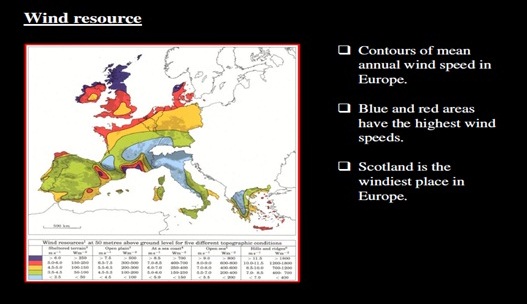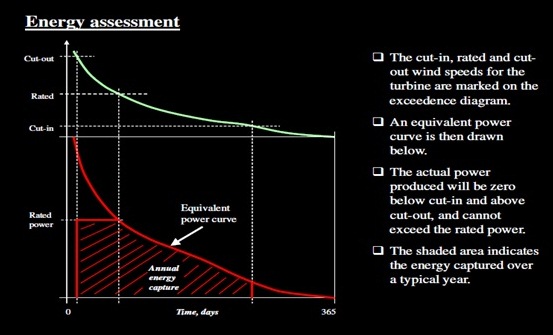Wind Turbines Literature Review
Introduction
A wind turbine is a device that converts kinetic energy from the wind, also called wind energy, into mechanical energy; a process known as wind power. If the mechanical energy is used to produce electricity, the device may be called a wind generator or wind charger. Wind turbines are of different sizes and capacities.
Wind Resource
A quantitative measure of the wind energy available at any location is called the Wind power density(WPD) It is a calculation of the mean annual power available per square meter of swept area of a turbine, and is tabulated for different heights above ground. Calculation of wind power density includes the effect of wind velocity and air density.
Shown in the image below is the wind resource of Europe.

Wind speed variation at a given site follows a statistical pattern which would be summarised as a weibull distribution showing the probability of occurrence of various wind speeds, as shown in the image on the right.

Two types of noises are generated by wind turbines:Aerodynamic (from the blades) and mechanical (from the rotating machinery). Mechanical noises can be minimised using well-proven engineering practices.
Minimum distance between turbines is been detailed in the following website. Wind turbine minimum distances.
Incentives
There are several grant schemes which offer funding to small scale renewables, particularly for the domestic and community sector. All the details about the grants can be found in the website below check current government grants.
The UK Government believes that renewables have a significant role to play in the future electricity generation mix and that the stimulus provided by the development of a carbon market through the EU Emissions Trading Scheme (EU ETS) and the Renewables Obligation will lead to growth in Renewables development in the future, as outlined in the website below. view Renewables Obligation.
References
www.engineeringtoolbox.com/sound-level-d_719.html
www.sengpielaudio.com/calculator-distance.htm
www.solacity.com/SiteSelection.htm
www.solar-facts-and-advice.com/
www.energysavingtrust.org.uk/Generate-your-own-energy/Wind-turbines
© University of Strathclyde